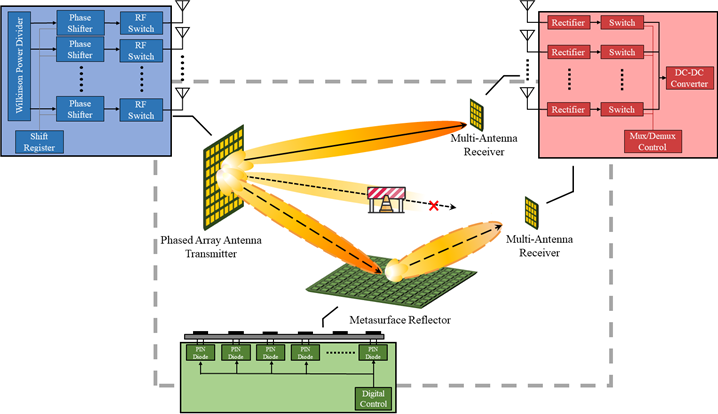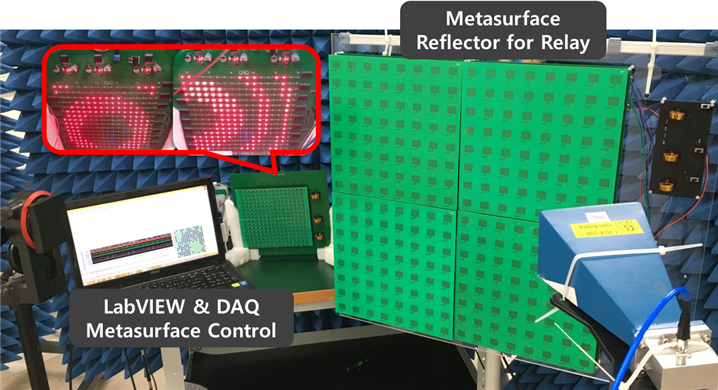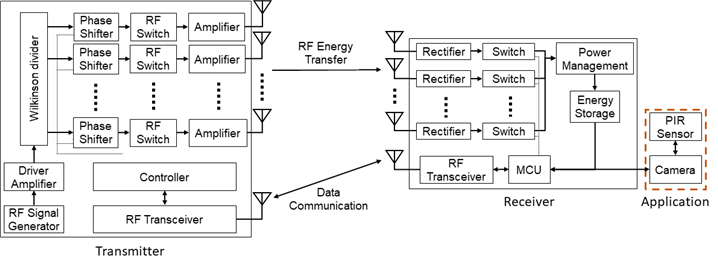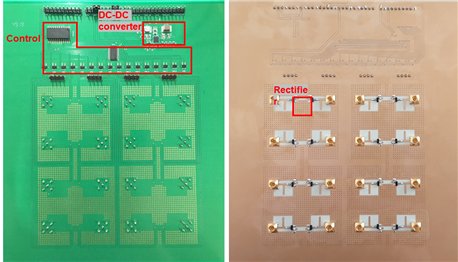
We are recruiting a couple of highly self-motivated graduate students who will work on Internet-of-Things (IoT) systems. Please, feel free to contact Prof. Kae-Won Choi (email: kaewonchoi@skku.edu) for more information.
Research Area
A study on mmWave communications based on reconfigurable metasurface
Overview
In this research project, we aim to develop a mmWave communications system based on reconfigurable metasurface. By adopting reconfigurable metasurface technology to ultra high frequency range communication technology, we can overcome inevitable limitations caused by using high frequency electromagnetic wave such as tremendous amount of path loss and shaded area due to the high straight forwardness characteristic.

Challenge
To this end, we study the channel estimation, beamforming and precoding techniques for reconfigurable metasurface with the theoritical analysis of overall system. Moreover, we also research the direct modulation technology of metasurface for massive multi user holographic communication. The proposed communication system and reconfigurable metasurface will be tested on a prototype testbed to verify the practical applicability of the developed techniques.
Process
To this end, we study the channel estimation, beamforming and precoding techniques for reconfigurable metasurface with the theoritical analysis of overall system. Moreover, we also research the direct modulation technology of metasurface for massive multi user holographic communication. The proposed communication system and reconfigurable metasurface will be tested on a prototype testbed to verify the practical applicability of the developed techniques.
Energy Maintenance Wireless Power Camera System
Overview
The Research proposes a system in which a wireless power camera that operates by being wirelessly powered and actively maintains energy. The power management includes not only transmission power control in the power transmission apparatus as the transmitting end but also control in the wireless power camera operating unit as the receiving end. For such control, the power transmitter and the wireless power camera operator may exchange control information through a transceiver.
The wireless power camera operating unit measures the remaining energy of the energy storage connected to the wireless power camera operating unit. When the residual energy is below a certain level, power is requested to the power transmitter through the transceiver. The power transmitter determines beamforming based on the position of the wireless power camera operating unit according to the request. The wireless power camera operating unit transmits photographing and data as motion is detected, and can actively request energy from the power transmitter based on the remaining energy. An object of the present research is to implement a fully wireless camera that can maintain the camera without replacing the battery in a place difficult to access through this.

Multi-Antenna based Long-Range Wireless Power Transfer System with Reconfigurable Metasurface Reflector
Overview
The whole system is made up of phased array antenna transmitter, RF-DC convert circuits receiver and 1-bit coding metasurface reflector. To tackle its low power transfer efficiency between transmitter and receiver, which is the foremost obstacle of radio frequency (RF) based WPT, we have implemented high-efficiency microwave beam synthesizing with multiple antennas. Inevitable shaded area due to the various kinds of obstacles between transmitter and receiver has been solved by deploying reconfigurable metasurface near the shaded area. In the case that transmitter detects obstacle in the middle, energy beam from the transmitter would be steered to metasurface and then by converting the phase of incident electro-magnetic waves of each cell in metasurface, transmitted power can be focused to receiver as well. With proposed convergent power transfer algorithm that handles all hardware components at the same time, optimized power transfer efficiency can be achieved regardless of whether the obstacle detected or not.


Challenge
The whole system is made up of phased array antenna transmitter, RF-DC convert circuits receiver and 1-bit coding metasurface reflector. To tackle its low power transfer efficiency between transmitter and receiver, which is the foremost obstacle of radio frequency (RF) based WPT, we have implemented high-efficiency microwave beam synthesizing with multiple antennas. Inevitable shaded area due to the various kinds of obstacles between transmitter and receiver has been solved by deploying reconfigurable metasurface near the shaded area. In the case that transmitter detects obstacle in the middle, energy beam from the transmitter would be steered to metasurface and then by converting the phase of incident electro-magnetic waves of each cell in metasurface, transmitted power can be focused to receiver as well. With proposed convergent power transfer algorithm that handles all hardware components at the same time, optimized power transfer efficiency can be achieved regardless of whether the obstacle detected or not.
Development of GHz microwave energy charging system for smart IoT devices
Overview
Microwave energy charging system has been developed aiming to introduces a new alternative and ready to be commercially used long-range wireless charging devices. Unlike the near-field wireless charging commercial product, (e.g. wireless phone charger), proposed system utilize the property of electromagnetic wave to wirelessly transfer the energy from the far distance. Besides that, with the implementation of massive MIMO technology, the power transfer efficiency and the operational range can be significantly improved by using beamforming technique implemented on the this system.



5G Beamforming
Overview
In a communication system utilizing beamforming, a beam alignment process is essential, and the overhead in this process is significant. In the case of A6G (Above 6GHz), more than 1000 beams are used. In order to satisfy various requirements of 5G, efficient beam alignment method is required in each scenario, the beam must be electrically steering In the direction of the terminal belonging to the cell, interference should be minimized through nulling. That is, a beamforming technique is needed to quickly find a terminal device where it may be located, start communication by aligning the beams, track movement well, and quickly recover when a communication link is broken due to surrounding conditions. We have optimized the algorithm using the Gradient Descent method so that it has various directivity and nulls and a radiation pattern of various beam-widths.

Challenge
We propose a method of adjusting only the phase of the feed signal by optimizing it with the objective function and computation process. We propose a beam synthesis method that can be effectively used in a communication system with a lot of limitations, and propose an initial access method of a millimeter wave communication system utilizing a planar array antenna using a synthesized beam.
Process
In order to effectively utilize the beam, research for forming various beams through beam synthesis is required. And initial access process is introduced by using several beam form to shoot the optimum beam.
Beam Avoidance for Human Safety in Radiative Wireless Power Transfer
Overview
The research proposes a beam steering algorithm to formulate the optimal phased antenna array weight that maximizes the received power on the target (IoT device) and at the same time maintains the amount of radiated microwave power toward human body below the recommended exposure limit. The research is motivated by the scientific studies about the human health risk that could be caused by microwave radiation exposure (e.g., heart disease, burns, skin cancer, etc).

Challenge
In this research, the information of the exact location of human body is required to apply the algorithm to the system. Therefore, by incorporating a depth camera which utilizes the sensing technology based on human stereo vision with a deep learning-based real-time object detection system, the human presence can be detected, the distance from the power beacon to human body can be measured, and the window size of detected object can be obtained.
Process
The proposed algorithm has the main advantage to assure the use of RF radiated energy in wireless power transfer environment complies with the limit of human exposure to the microwave energy, which is regulated by communication international commission. The proposed algorithm can be easily applied and adapted to the receive power-based wireless power transfer employing a large number of antenna.
Study on Frequency Sharing Algorithms Based on Radio Wave Environment Information Using Machine Learning
Overview
Today, as the use of communication devices increases, a high-density network environment has also increased, and thus limited channel resources must be efficiently used. Since the existing fixed algorithm was developed to be used in the overall communication environment, there is a limit to the performance improvement over a certain level in the actual environment. If a communication algorithm using a reinforcement learning model is used, it is possible to maximize the use of channel resources by learning the data of the current environment, and to find a communication algorithm optimized by itself according to the changing environment.

Challenge
Therefore, in this study, we implement a frequency sharing environment simulator and develop a reinforcement learning model that optimizes communication algorithms according to the changing environment using the simulator.
Wireless Power Transfer for Communication Networks
Overview
In this research topic, we study the radio frequency (RF) power transfer technique that makes use of an electromagnetic (EM) wave as a medium for carrying power. Differently from other wireless power transfer techniques (e.g., inductive coupling and magnetic resonant coupling), the RF energy transfer technique enjoys an advantage of longer energy transfer distance compared to other competing technologies thanks to the characteristics of the EM wave. Especially, we study a multi-antenna wireless-powered sensor network (WPSN), in which a power beacon wirelessly transfers electric energy to a sensor node via an EM wave.

SDR Development based on Ultra Dense Network
Overview
The ultra-dense network (UDN) is a next generation communication technology that can maximize spectral efficiency per unit area by simultaneously transmitting and receiving information through the same spectrum to multiple terminals through cooperative communication between a plurality of base stations arranged at very high density. In this research, we design UDN test bed based on software defined radio (SDR) platform to improve spectral efficiency of UDN structure in ultra high density environment and verify UDN core technology.

Challenge
We can modify the parameters such as modulation order, transmit power, and basis vector size, etc. in the top-level VI of the LabVIEW code and check the performance metrics such as bit-error rate (BER), signal-to-noise ratio (SNR), channel gain, and signal constellation of each receiver. We have conducted experiments that measure these performance metrics according to various parameters.
Process
And one of the many challenges in the development and evaluation of these wireless systems is testing and verification. Therefore, the radio system must be tested to ensure specified requirement. But field tests are expensive, time-consuming, and difficult to repeat. Simulation can overcome these problems, but ultimately it is limited to accuracy or excessive running time. One way to compensate for these limitations is the real-time HIL channel emulation. This can compensate for the gap between simulation and field testing. A good channel emulator can test a wireless system in repeatability, high accuracy, and various network scenarios.